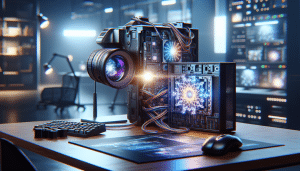AI Tools You Can Use to Simplify Everyday Life
Aiden Foster September 1, 2025
Artificial intelligence is everywhere, quietly shaping daily routines and work habits. This guide explores how the latest AI tools are transforming productivity, creative tasks, cybersecurity, data analysis, and decision-making—giving you the edge in the digital world.
AI Integration in Productivity Apps
Integrating artificial intelligence into productivity apps has completely changed how individuals manage tasks and calendars. AI-powered calendars, for example, do more than just schedule meetings—they analyze your patterns, suggest optimal meeting times, and automate reminders. Many people find these tools helpful for keeping their days streamlined. As AI evolves, popular office suites embed features like automated email sorting, intelligent recommendations, and real-time translation, raising overall efficiency for users worldwide.
AI algorithms help sort complex data and prioritize your most important tasks. Instead of manually scanning through hundreds of notifications or emails, smart assistants highlight urgent action items, reducing cognitive overload. Some platforms now integrate voice recognition, allowing verbal commands or dictation for setting reminders, sending messages, or searching files hands-free. The focus is always on relieving routine burdens so users can allocate their time to creative or strategic thinking.
Automated transcription and note-taking features powered by artificial intelligence are helping transform meetings. Instead of scrambling to jot down every insight, participants can rely on AI to capture, summarize, and organize notes. This is especially valuable in remote or hybrid workplaces where capturing and distributing accurate records is essential. Over time, these tools refine their understanding of individual work styles, offering even more personalized productivity support.
AI-Assisted Creative Design and Content Creation
Artificial intelligence is making waves in creative industries as well. Graphic designers, marketers, and writers are adopting AI-powered platforms that suggest layouts, automate editing, and generate content drafts based on brief prompts. This doesn’t replace human creativity but instead acts as a collaborator—providing inspiration, rapid mockups, and refinements. For individuals with limited design training, these platforms open the door to professional-quality visuals, whether for presentations or social media.
Content creation is also changing rapidly. AI writing assistants help overcome writer’s block by offering suggestions for wording, grammar, and even topic ideas. They adapt to your tone, drawing on huge databases to mimic natural language patterns. Some programs can generate instant video captions or synthesize voices for podcasts and presentations. These features allow teams to scale up content output while maintaining consistency and quality standards, especially when demands are high.
AI-driven editing technology ensures quality control. Real-time spell checking, advanced grammar corrections, and plagiarism detection are common, but newer systems go further—they analyze structure, recommend rephrasing, and highlight unclear sections. The result? Creators spend more time ideating and less time fixing errors. Creative professionals increasingly see AI as an accelerator, helping them meet tight deadlines and high expectations without sacrificing originality.
Enhancing Cybersecurity with AI
With the surge in daily online activities, cybersecurity has become a major concern. Artificial intelligence is now a core component of many security systems, actively monitoring for suspicious behaviors or emerging threats. Instead of relying solely on static rules, AI adapts in real-time—identifying patterns of fraud, unauthorized access, or data leaks before they escalate. This dynamic, learning-based approach greatly reduces risk in both personal and professional spheres.
Some antivirus tools employ machine learning to analyze files, emails, and network traffic. They detect previously unknown malware based on behavior rather than waiting for software updates. For example, AI-powered firewalls continuously analyze traffic to distinguish between legitimate and malicious actions, while spam filters update themselves by learning from user feedback. This ongoing adaptation is key for defending against fast-evolving cyber threats in a hyperconnected world.
Multifactor authentication processes now leverage AI to gauge user behavior and spot anomalies. Sudden login attempts from unusual locations or devices are flagged and, in some cases, proactively blocked. AI algorithms can also suggest stronger passwords, alert users to potential phishing attempts, and minimize human error in digital protection. The growing integration of these technologies means more people are benefitting from secure, AI-augmented digital environments.
AI in Data Analysis and Decision-Making
Data analysis, once limited to experts, is now accessible to wider audiences due to intuitive AI tools. Artificial intelligence can comb through huge datasets in seconds, revealing trends and outliers that would take human analysts days to identify. These platforms transform raw information into visual dashboards and actionable insights, helping everyone from small business owners to researchers make better decisions backed by data.
Predictive analytics powered by AI inform financial forecasting, healthcare planning, and even environmental monitoring. For example, retailers use AI to predict purchasing trends, optimize inventory, and personalize customer experiences. In healthcare, machine learning analyzes patient records to identify early signs of disease or recommend preventive steps. Across all fields, this technology empowers people to act proactively instead of reactively.
Interactive AI assistants make sophisticated analytics user-friendly. By asking plain-language questions, users can get complex answers without specialized training. These systems are transforming how organizations interpret their own data, supporting faster responses and more strategic resource allocation. Ultimately, the democratization of analytics means anyone can harness data to answer important questions and solve problems in their daily lives.
Personalized Learning and AI-Driven Education
Education has embraced artificial intelligence to support both students and teachers. Adaptive learning platforms analyze student responses and tailor lessons in real time, responding to strengths and weaknesses. This ensures learners get targeted practice where they need it most, ideal for diverse classrooms or individuals with unique pacing. Teachers also benefit: AI streamlines grading and offers suggestions for differentiated instruction.
AI chatbots and virtual tutors provide on-demand support for students tackling new or challenging content. These systems deliver hints, explanations, or additional practice at any hour, bridging gaps in understanding. Some universities and training programs use AI to match students with courses or resources best suited to their interests and goals, optimizing academic pathways with data-driven recommendations.
Language learning apps employ advanced speech recognition and correction algorithms. AI recognizes pronunciation errors, offers feedback, and tracks progress over time. This continuous feedback loop encourages regular practice, making language acquisition more engaging and efficient. As the technology evolves, more people can access personalized, AI-enhanced educational experiences—regardless of background or location.
Smart Home and Connectivity Improvements
Smart homes rely heavily on artificial intelligence to deliver personalized, streamlined experiences. Voice-activated assistants allow control of lighting, temperature, appliances, and even security systems from anywhere. These devices use AI to learn routines, adapting suggestions and automations to suit unique lifestyles. Many homeowners enjoy the convenience of hands-free management alongside greater energy efficiency.
Connected home appliances leverage AI for predictive maintenance. Washing machines, refrigerators, and HVAC systems flag potential issues before breakdowns occur, enabling preventive repairs that save time and expense. In multi-device households, AI algorithms optimize bandwidth, reduce connectivity issues, and coordinate entertainment or work needs—ensuring smoother experiences for everyone under one roof.
Home security has also benefited from AI integration. Camera systems equipped with artificial intelligence distinguish between common events—such as a family member arriving—and truly unusual activity, reducing unnecessary alerts. Over time, these tools adapt to household habits, enhancing both peace of mind and accessibility for residents at every stage of life.
References
1. European Commission. (n.d.). Ethics guidelines for trustworthy AI. Retrieved from https://ec.europa.eu/digital-strategy/our-policies/european-approach-artificial-intelligence/ethics-guidelines-ai
2. National Institute of Standards and Technology. (n.d.). Artificial Intelligence. Retrieved from https://www.nist.gov/artificial-intelligence
3. Harvard Business Review. (n.d.). How AI Is Changing Knowledge Work. Retrieved from https://hbr.org/2022/12/how-ai-is-changing-knowledge-work
4. Future of Privacy Forum. (n.d.). AI and Privacy. Retrieved from https://fpf.org/issues/ai-and-machine-learning/
5. EDUCAUSE. (n.d.). Artificial Intelligence in Education. Retrieved from https://www.educause.edu/eli/initiatives/7-things-you-should-know-about-series/7-things-you-should-know-about-artificial-intelligence-in-education
6. MIT Sloan Management Review. (n.d.). The Risks and Benefits of AI. Retrieved from https://sloanreview.mit.edu/article/the-risks-and-benefits-of-ai/








